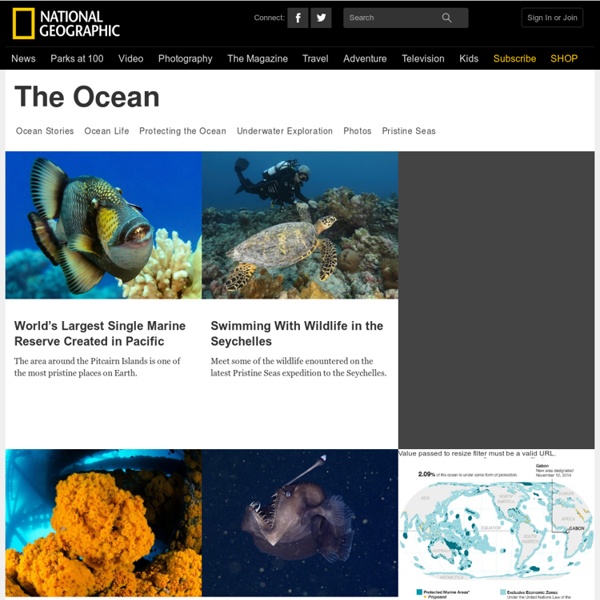Ocean
An ocean (from Ancient Greek Ὠκεανός, transc. Okeanós, the sea of classical antiquity[1]) is a body of saline water that composes much of a planet's hydrosphere.[2] On Earth, an ocean is one of the major conventional divisions of the World Ocean, which occupies two-thirds of the planet's surface. These are, in descending order by area, the Pacific, Atlantic, Indian, Southern, and Arctic Oceans.[3][4] The word sea is often used interchangeably with "ocean" in American English but, strictly speaking, a sea is a body of saline water (generally a division of the world ocean) partly or fully enclosed by land.[5] Earth's global ocean[edit] Global divisions[edit] Various ways to divide the World Ocean
Seafood Network Information Center
Ocean Facts
Interesting Ocean Facts Area: about 140 million square miles (362 million sq km), or nearly 71% of the Earth's surface. Average Depth: 12,200 feet (3,720 m). Deepest point: 36,198 feet (11,033 m) in the Mariana Trench in the western Pacific.
Sea Anemones
As of July 1, 2013 ThinkQuest has been discontinued. We would like to thank everyone for being a part of the ThinkQuest global community: Students - For your limitless creativity and innovation, which inspires us all. Teachers - For your passion in guiding students on their quest. Partners - For your unwavering support and evangelism. Parents - For supporting the use of technology not only as an instrument of learning, but as a means of creating knowledge.
Earth's Oceans
Advertisement. EnchantedLearning.com is a user-supported site. As a bonus, site members have access to a banner-ad-free version of the site, with print-friendly pages.Click here to learn more. (Already a member?
Marine Conservation Organizations
MarineBio is deeply committed to marine conservation and founded on the concept that, by sharing the wonders of the ocean and marine life, people will be inspired to protect it. We hope you will consider becoming a MarineBio Conservation Society member to help us bring the ocean and the conservation message to as many people as possible. There are many other organizations working on marine conservation and other environmental issues such as biodiversity and global warming. We list them here both as a public service and to spread the word.
Marine biology
Only 29 percent of the world surface is land. The rest is ocean, home to the marine lifeforms. The oceans average nearly four kilometres in depth and are fringed with coastlines that run for 360,000 kilometres.[1][2] A large proportion of all life on Earth exists in the ocean.
Seahorses, Seahorse Pictures, Seahorse Facts
Seahorses are truly unique, and not just because of their unusual equine shape. Unlike most other fish, they are monogamous and mate for life. Rarer still, they are among the only animal species on Earth in which the male bears the unborn young. Found in shallow tropical and temperate waters throughout the world, these upright-swimming relatives of the pipefish can range in size from 0.6 inches (1.5 centimeters) to 14 inches (35 centimeters) long. Male seahorses are equipped with a brood pouch on their ventral, or front-facing, side.
Pacific 'garbage patch' changing insect mating habits
Marine insects in the Pacific Ocean are changing their reproduction habitats in response to environmental changes from the accumulating amount of rubbish in the north Pacific subtropical gyre, also known as the great Pacific garbage patch, according to researchers. The patch has increased in size 100 times since the 1970s, including its swath of microplastic particles of less than 5mm diameter. The marine insect Halobates sericeus, a species of water skater, is now using the microplastic debris as a surface to lay its eggs, said a study by the Scripps Institution of Oceanography at University of California San Diego, published on Wednesday in the Royal Society journal Biology Letters.



